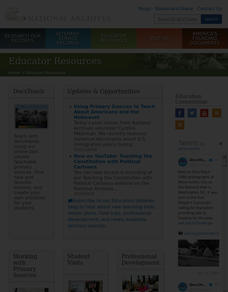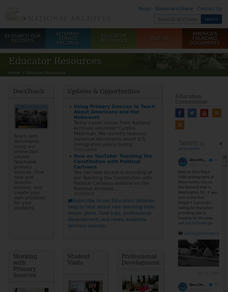Curated OER
Why is Delaware Called "The First State"?
Young scholars learn why Delaware is called the First State and the background leading to Delaware's ratification of the US Constitution. Students, in groups, choose an individual in today's world that has the greatest influence on their...
Curated OER
The U.S. Constitution: Practical Application of the Amendments
Pupils create their own HyperStudio cards which include scanned images of at least one member (designated reader) of each group. They add the text of a predetermined amendment. The designated reader then reads the selected amendment.
Curated OER
It's Time to Put Our Money Where Our Mouths Are
Eighth graders choose a person who should be honored on our currency. They write a letter outlining the reasons for their choice.
Curated OER
CIVIL DISOBEDIENCE
Students use events of the time to illustrate the significance of the 1965 Selma-to-Montgomery Voting Rights March.
Curated OER
All Men Are Created Equal
Students discuss the statement "All Men Are Created Equal". Using the internet, they research events in history in which this statement has been ignored and supported by the government. They use this information to write an essay about...
Curated OER
BIRTH OF AN EXCEPTIONAL NATION
Students compare the 2 paintings "Washington Crossing the Delaware" and "Prayer at Valley Forge". Look for similarities, differences and information on the painters. Create a political game board using the events from 1776.
Curated OER
Lesson I - Why is Delaware Called "The First State"?
Students discuss why Delaware is called the First State, research background leading to Delaware's ratification of United States Constitution, complete worksheet on United States Constitution, and work in groups to choose an individual...
Curated OER
Art Reflects Life
Fifth graders use the Internet to view collections of famous artists throughout the eighteenth century America. Using the artwork, they identify the themes that portrayed America as the land of opportunity. They record their findings...
Curated OER
Sow the Seeds of Victory!
Pupils use the National Archives and Records Administration's records to research the history of the U.S. Food Administation.
Curated OER
Voting and the U.S. Constitution (Past, Present, and Future), Part 2
Students analyze and discuss the 19th Amendment, and read the document, Why Women Want to Vote. Students illustrate statements from the handbill, then conduct a play about women's suffrage.
Curated OER
American Civilization
First graders research and examine various events during the American Revolution. They locate the thirteen colonies on a map, create Boston Tea Party boats, and construct Paul Revere paper lanterns.
Curated OER
All Men Are Created Equal Except...
Students discuss the line "all men are created equal" in a time of slavery. They discover how equaliy and liberty changed over time in America. Role-playing different scenerios, they analyze the experiences of real-people coming to...
Curated OER
USA Celebrations and Holidays
In this USA holiday and celebrations learning exercise, 5th graders complete a set of 17 questions about holidays and celebrations. Students may click on an answer button beneath each sentence to check their work.
Curated OER
Sioux Treaty of 1868
Students explore and research the history of Native Americans in North America.
Curated OER
Photographs of Lewis Hine: Documentation of Child Labor
Young scholars use the Archival Research Catalog to complete assignments and activities about Lewis Hines and the National Child Labor Committee.
Curated OER
Constitutional Issues: Separation of Powers
Students discribe the principle and the history of separation of powers.
Curated OER
D-Day Message from General Eisenhower to General Marshall
Students use documents in the National Archives of the United States to evaluate the effectiveness of D-Day.
Curated OER
Memorandum Regarding the
Students use the National Archives to research the memorandum regarding the enlistment of Navajo Indians during World War II.
Curated OER
Telegram from Senator Joseph McCarthy to President Harry S. Truman
Young scholars research Senator Joseph McCarthy's February 9, 1950 speech, given at Wheeling, West Virginia, in which he claimed more than 200 State Department employees were members of the Communist Party.
Curated OER
Memorandum of a Conference with President Eisenhower after Sputnik
Students use the National Archives to research how the United States and the Soviet Union south to maintain its supremacy after World War II.
Curated OER
Court Documents Related to
Students use the National Archives to researcj cout coduments related to Martin Luther King, Jr.
Curated OER
With Liberty and Justice for All
Fifth graders identify and define in their own words the first ten amendments to the Constitution. They are assigned a CDV or amendment from the Bill of Rights and create and present a one-minute skit demonstrating it.
Curated OER
Ratification Debate on the U.S. Constitution
Learners study the U.S. Constitution and are asked to give a speech about what they have found.
Curated OER
Civil War Time Line
Students draw a time line on graph paper on a scale of one square to every five years beginning in 1770 and ending at 2000. They place historic events and inventions in their correct time period on the time line, and add their birthday...

























